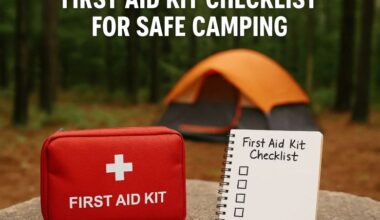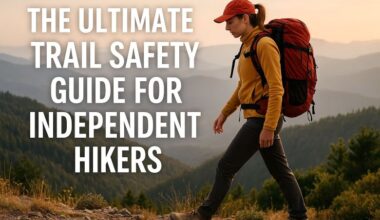Hiking is a terrific way to connect with nature, get exercise, and clear your mind. But the weather can change fast and turn your adventure into a danger if you’re not prepared. Every year, thousands of outdoor accidents happen because hikers aren’t ready for sudden storms, cold snaps, or intense heat.
In fact, according to national outdoor safety data, weather-related incidents make up a significant portion of rescue calls. Just a few years ago, hikers caught in storms on the Appalachian Trail had to be rescued after being caught in unexpected lightning.
To enjoy the outdoors without risking your safety, focus on these five key tips that can keep you safe.
Plan Your Hike with Weather Forecasts in Mind
Check Accurate Weather Reports Before Heading Out
Before you hit the trail, always look up the latest weather reports. Trustworthy sources include the National Weather Service or popular weather apps. These platforms offer real-time updates and alerts about storms, temperature changes, or high winds.
Checking forecasts helps you decide whether to go or wait for better conditions. During your hike, keep a close eye on the weather, since conditions can change quickly.
Understand Local Microclimates and Terrain
Did you know that microclimates can exist just a few miles apart? In some areas, a valley might be foggy and cold, while the open sky above is sunny and warm.
Understanding these little weather differences helps you prepare accordingly. For example, a forested trail might block wind but trap moisture, making it wetter and colder. Research the trail and terrain beforehand to identify potential weather hazards.
Adjust Your Plans Based on Forecasted Conditions
If severe weather warnings appear, don’t hesitate to postpone your hike. Flexibility saves lives. Trying to push through a thunderstorm might seem tough, but it’s dangerous. Modify your route, or consider waiting until the weather clears.
Putting safety first means knowing when to change plans. It’s better to arrive home safely than risk a weather-related accident.
Gear Up Properly for All Conditions
Essential Clothing for Wet, Cold, and Windy Weather
Layering clothing is your best defense against changing weather. Start with a moisture-wicking base layer to keep sweat away from your skin. Add an insulating layer for warmth, like fleece or synthetic material.
Finish with a waterproof shell that blocks rain and wind. Breathable, quick-drying fabrics help you stay comfortable, even if it worsens.
Must-Have Safety Equipment
Pack a sturdy, waterproof backpack with rain covers, extra clothing, and emergency supplies. Items like a headlamp, whistle, and your first aid kit should always be in your pack. Use trekking poles to stabilize yourself on slippery or uneven ground.
They help prevent falls and provide balance in gusty wind or icy conditions.
Use of Technology and Safety Devices
Modern tech is a game-changer for outdoor safety. Carry a GPS device or a fully charged smartphone with navigation apps. A radio or personal locator beacon can send an SOS when trouble strikes.
These devices are especially valuable in remote areas where cell service may be weak or unavailable.
Recognize and Respond to Weather Changes During the Hike
Signs of Imminent Storms or Dangerous Weather
Dark clouds gathering overhead, a sudden drop in temperature, or wind shifting direction can warn of storms coming. Physical signs like a sudden increase in wind speed or a sharp drop in visibility mean you need to act fast.
Use your devices to stay updated on weather alerts, even during the hike.
Situational Responses
If bad weather approaches, find nearby shelters like caves, overhangs, or dense trees away from open fields and water. Stay low and keep your body warm. If caught in wind or rain, minimize exposure by covering your head and hands; staying dry and warm prevents hypothermia.
Handling Sudden Weather Emergencies
In a lightning storm, avoid tall trees or open spaces. Drop to the ground and make yourself as small as possible. Seek shelter in a low-lying spot or inside a vehicle or building if available.
Calmly evaluate your options, and don’t panic. Quick, sensible decisions save lives.
Know Your Limits and Postpone When Necessary
Assessing Physical and Mental Readiness
Watch for signs of fatigue, dizziness, or confusion. These could be signs of hypothermia or dehydration. Know your personal limits; pushing beyond them in bad weather can be deadly. Rest and hydrate as needed, and don’t ignore warning signs.
Understanding Trail Difficulty and Weather Impact
Match the trail difficulty with your experience level. Challenging terrain under perfect conditions is tough enough; add bad weather, and risks multiply. Use maps and trail guides to identify tougher sections, and plan to avoid them during storms, extreme heat, or snow buildup.
The Value of Flexibility and Decision-Making
Sometimes, delaying a hike is the smartest move. Many accidents happen because hikers ignore weather warnings or push through bad conditions. Communicate any changes in plans with friends or family, and don’t be afraid to call off the hike if conditions worsen.
Prepare an Emergency Plan and Communication Strategy
Share Your Itinerary and Expected Return Time
Always tell someone reliable where you’ll be and when you expect to return. Share your route and check-in times. Using smartphone apps or devices that share your location helps family or friends track you during your adventure.
Carrying Emergency Supplies and First Aid Kit
Your pack should include basics like extra clothing, water, snacks, and a fully stocked first aid kit. Fire-starting tools, a flashlight, and an emergency blanket are also vital. Basic first aid knowledge can help you treat cuts, sprains, or hypothermia until help arrives. Want to know what to pack in your first aid kit? Read our blog on first aid checklist for camping
Know How to Use Emergency Devices
Learn how to operate your GPS, personal locator beacons, and signaling devices before heading out. Use them only in real emergencies. Practice makes perfect, and knowing how to call for help can save valuable time in remote areas.
Conclusion
Hiking in any weather demands careful planning, proper gear, and quick thinking. Don’t forget, you can be surprised, so always stay alert and flexible. By preparing thoroughly, understanding your environment, and knowing how to respond, you can enjoy nature safely and avoid unwanted adventures.
Remember, safety first makes every hike more enjoyable. Always respect the weather, and you’ll have many more adventures to look forward to. Thinking of going on your next adventure? Subscribe to our blog for more safety tips!




